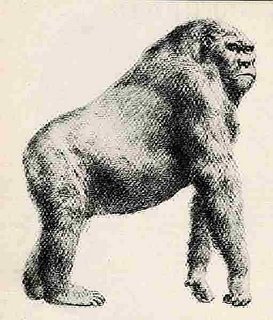
Gigantopithecus blacki
From Wikipedia, the free encyclopedia.
Jump to: navigation, search
?
Gigantopthecus blacki
{{{status}}}
Fossil range: Pleistocene (~100 TYA)
Scientific classification
Domain: {{{domain}}}
Superkingdom: {{{superregnum}}}
Kingdom: Animalia
Subkingdom: {{{subregnum}}}
Superdivision: {{{superdivisio}}}
Superphylum: {{{superphylum}}}
Division: {{{divisio}}}
Phylum: Chordata
Subdivision: {{{subdivisio}}}
Subphylum: {{{subphylum}}}
Infraphylum: {{{infraphylum}}}
Microphylum: {{{microphylum}}}
Nanophylum: {{{nanophylum}}}
Superclass: {{{superclassis}}}
Class: Mammalia
Sublass: {{{subclassis}}}
Infraclass: {{{infraclassis}}}
Superorder: {{{superordo}}}
Order: Primates
Suborder: {{{subordo}}}
Infraorder: {{{infraordo}}}
Superfamily: {{{superfamilia}}}
Family: Hominidae
Subfamily: Ponginae
Supertribe: {{{supertribus}}}
Tribe: {{{tribus}}}
Subtribe: {{{subtribus}}}
Genus: Gigantopithecus
Subgenus: {{{subgenus}}}
Section: {{{sectio}}}
Series: {{{series}}}
Species: G. blacki
Subspecies: {{{subspecies}}}
[[{{{diversity_link}}}|Diversity]]
{{{diversity}}}
Binomial name
Gigantopithecus blacki
Koenigswald, 1935
Trinomial name
{{{trinomial}}}
Type Species
{{{type_species}}}
{{{subdivision_ranks}}}
[[Image:{{{range_map}}}|{{{range_map_width}}}|]]
Synonyms
{{{synonyms}}}
Gigantopithecus blacki (Greek and Latin for "Black's Giant Ape") is an extinct species of ape.
Contents
[hide]
* 1 Characteristics
* 2 Classification
* 3 Cryptozoology
* 4 See also
* 5 References
* 6 External links
[edit]
Characteristics
The only known fossils of G. blacki are a few teeth and mandibles found in cave sites in Southeast Asia. As the name suggests, these are appreciably larger than those of living gorillas, but the exact size and structure of the rest of the body can only be estimated in the absence of additional findings. Recent research using high-precision absolute-dating methods has shown that after existing for about a million years, G. blacki died out 100,000 years ago. This means that it coexisted with (anatomically) modern humans (Homo sapiens) for a few dozen thousands of years, and with the most immediate ancestors of H. sapiens before that.
Based on the fossil evidence, paleontologists speculate that Gigantopithecus had an adult height of over three meters (ten feet) and a weight of 550 kg (1200 lb), and was thus much larger and heavier than current-day gorillas.
The species lived in Asia and probably inhabited bamboo forests, since its fossils are often found alongside those of extinct ancestors of the panda. Most evidence points to Gigantopithecus being a plant-eater. Some believe that being a plant-eating species, G. blacki was placed at the losing end of the evolutionary competition with humans.
Gigantopithecus's method of locomotion is uncertain, as no pelvis or leg bone has been found. The dominant view is that it walked on all fours like modern gorillas and chimpanzees; however, a minority opinion, most notably championed by the late Grover Krantz, holds that the mandible shape and structure suggests bipedal locomotion.
[edit]
Classification
In the past, it had been thought that G. blacki was an ancestor of humans, on the basis of molar evidence; this is now regarded a result of convergent evolution. G. blacki is now placed in the subfamily Ponginae along with the orangutan.
[edit]
Cryptozoology
Believers in the existence of the Yeti or "Abominable Snowman" and Bigfoot have theorized that these creatures could be present-day specimens of G. blacki. Without additional evidence, this must be regarded as highly speculative.
No comments:
Post a Comment